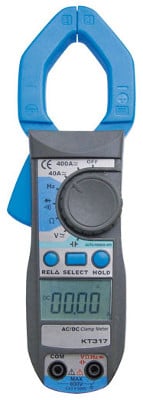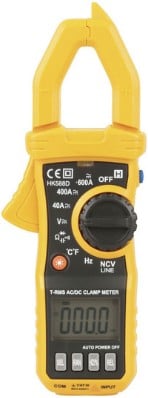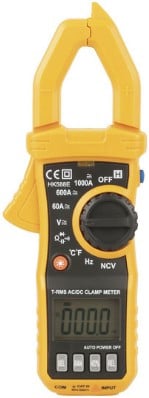How to Use Clamp Meters: Measuring Electricity
June 3, 2022

Clamp meters are essential for your electronic workbench.
A few basic hand tools and test equipment can get you started working with electronics. You do not need a workshop full of expensive instruments to get started.
Among the hardware that we recommend adding to your hobbyist tool kit are clamp meters. These test tools combine a basic digital multimeter with a current sensor.
In this post, we will discuss clamp meters in detail. From their basic principles to their main types and applications, learn all about them here.
What Are Clamp Meters?
A clamp meter is a type of test equipment which measures electric currents. You will find this device in many electricians’ and electrical engineers’ toolboxes.
The current sensor is located within the clamp, resembling the pincher of a digital meter. The hinged clamp jaw integrated into the meter allows you to clamp around conductors.
A release lever opens the clamp – to be placed around wires, cables, and other electric leads. Through this simple method, you can test currents in a power line without breaking any circuits.
The Working Principle
A clamp meter works on magnetic induction to measure AC without contact. Like every conductor, the current flowing through a wire produces a magnetic field.
It works by detecting and measuring the magnetic field generated by a current. The clamps are made of ferrite iron, surrounded by safe, hard plastic on the outside.
When clamped around a conductor, the ferrite iron interacts with the magnetic field. This provides the measurement of the current.
The hall effect sensor detects the magnetic field created by current flow. This process creates less voltage across the sensor. The sensor mainly detects magnetic field caused by low current flow.
To measure current, place a wire in the clamp meter’s claws. When current flows through a conductor, it generates a magnetic field.
Once the magnetic field is detected, the corresponding current reading can be provided.
Parts of a Clamp Meter
The clamp meter has various parts, and most of these are found on modern generation models:
Transformer clamps (jaws)
Jaws detect the magnetic field produced due to current flow.
Clamp opening trigger
The trigger opens and closes the transformer jaws.
Power switch
Used for turning the clamp meter on or off.
Backlight button
The illuminated LCD indicates that the backlight button is on. From there, you can see and read the on-screen value well at night.
Hold button
Press this button to see the value on the display.
Negative or ground input terminal
The meter cable’s negative or grounding jack is joined to this cover.
Positive input terminal
The meter cable’s positive jack is joined to this cover.
LCD
A display panel on the clamp meter allows you to check the measured values.
Functional rotary switch
Modern clamp meters can measure voltages, continuity, and resistance. This feature enables you to choose between different currents for measurement.
Two Types of Clamp Meters
There are two significant types of clamp meters, and these are:
- Current transformer clamp meter – AC measuring device
- Hall effect clamp meter – AC and DC measuring device
Current transformer clamp meter
Ferrites iron clamps are used in this type of clamp meter. Separately, copper coils cover the clamps. Combined, they form a magnetic core on the surface where the measurements are taken.
A current in a conducting material causes magnetic flux to form. This magnetic flux can measure the magnetic field. The Greek letter Phi (Φ) is used to represent it.
Hall effect clamp meter
This type of clamp meter can measure both AC and DC signals. It contains a concentrating magnetic field when the clamps are closed around the conductor.
As mentioned, a hall effect clamp meter can also concentrate DC magnetic fields. When it does, it must be zeroed to avoid errors. Interference can arise from the Earth’s magnetic field or other sources within the vicinity.
Major Applications of Clamp Meters
Clamp meters come in handy in both industrial and commercial aspects. Any time a project calls for checking the current of a circuit, one can be of use.
This makes it ideal for a wide range of potential uses, and below are some of the most common applications:
1. Troubleshooting
A clamp meter is essential test equipment and suitable for troubleshooting. Knowing how to use this tool quickly and safely is a must for electricians.
With a clamp meter, you can test the electrical current and voltage. Thanks to its functionality and versatility, it can read both measurements.
Use this handy tool whether you are testing a plant or a piece of machinery.
2. Electrical installations
Another essential in electrical work is the measuring and monitoring of electrical current. This is where a clamp meter comes into play. It is used across several contexts in electrical installations.
Ideal for installing residential, commercial and industrial electrical systems. Clamp meters are also useful when building and repairing industrial equipment and machinery.
3. For special training
For rookie electricians, it is crucial to be aware of all conditions on the job site. You can supervise them as they work to install or update equipment with a clamp meter.
During training, use the tool to monitor the system and get a quick and final circuit test.
4. Repairs and maintenance
In every HVAC (Heating, Ventilation, and Air Conditioning) technician’s toolbox, you will find a clamp meter. These specialists perform regular maintenance and checkups on HVAC systems.
In this process, it is essential to get quick and accurate readings on:
- Electrical current
- Resistance
- Voltage
The right clamp meter is a great all-in-one tool that serves this purpose well.
Get Your Clamp Meters Here!
Clamp meters are much like multimeters that “clamp” around a wire to measure current (amps).
Our range of Clamp Meters provide ultra-high current measurement. They are available in 400Amp, 600Amp, and 1000Amp AC and DC measurements.

Clamp Meter DC/AC 400A – No longer available
Product code: ME3160
Get reliable and accurate measurements with this DC/AC 400A clamp meter! It features a large scale integration circuit with double integration A/D converter.
Plus, it has a full range of overload protection. Other features include data hold, sleep mode and relative mode.
This unit can measure the following:
- AC/DC Voltage
- AC/DC Current
- Frequency
- Duty Cycle
- Resistance
- Diodes
- Continuity
To further protect the Clamp Meter DC/AC 400A, it comes with a carry pouch.
True RMS Clamp Meter AC 600V – No longer available
Product code: JQM1630
The 600A True RMS AC Clamp Meter is the ideal clamp for AC measurement applications. It features True RMS AC voltage and current measurements.
This allows you to measure AC to 600 A and AC voltage to 600V. Compact unit at a great price. Carry case included.

Clamp Meter AC DC True RMS 600Amp
Product code: JQM1632
This clamp meter unit includes high precision AC-DC measurement from a compact device. A price breakthrough for a DC capable clamp meter!
Special features include: non-contact voltage, LINE test, data hold, backlight, and relative measurement.

Clamp Meter AC/DC True RMS 1000Amp
Product code: JQM1634
Fantastic features at a great price! This clamp meter model provides ultra-high current 1000Amp AC and DC measurement.
Special features include: non-contact voltage, LINE test, data hold, backlight, and relative measurement.
The Bottom Line
Electronics can be a fun and rewarding hobby, especially when you have the right tools to do the job. One of these instruments is the clamp meter. With one, you can get measurements quickly and safely.
Generally, clamp meters measure electrical current, and their accuracy and convenience make them very useful. This has pushed manufacturers to optimise clamp meters by adding more features.
If you are an electrician, a clamp meter is surely a versatile diagnostic tool to have!
© Electrotech Brands Pty Ltd 2022


Write a Comment
You must be logged in to post a comment.